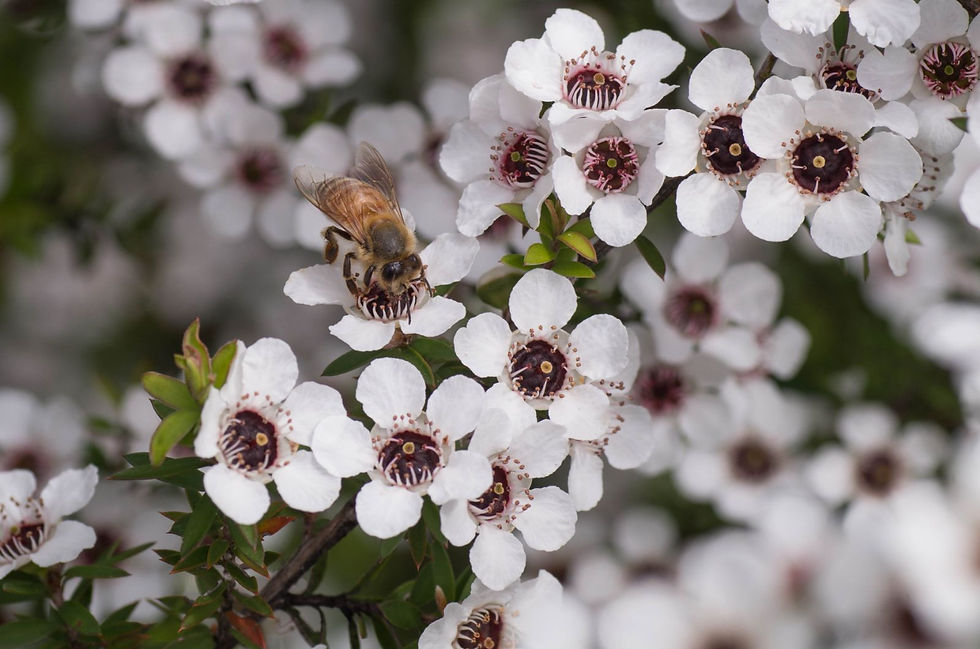Manuka (Leptospermum scoparium)
- MW+CD

- Aug 6, 2021
- 3 min read

Manuka (Leptospermum scoparium)
Growing up in New Zealand I often started my day with a nice slice of bread with Honey, deriving from the flowers of the Manuka tree. This wasn’t really something special back in my childhood, but now as research showed interesting beneficial health effects of the regular consumption of Manuka honey, the demand sky-rocketed in recent years and Manuka honey became an expensive and precious commodity, which is today exported from New Zealand all over the world. Its time to have a look into what makes this honey so precious.
The Manuka tree itself isn’t special or rare at all. It is a common tree in New Zealand and can be often found at the edge of the woods. It grows to about a height of 4 meters and you can easily recognise the tree, with his dark wood, long narrow leaves, and the beautiful white-pinkish flowers. If you are not hundred percent sure if it is a Manuka or not, just pick some leaves from the tree and rub or crunch them between your fingers. You will directly smell a strong resinous odour.
In the time of the first settlers, people made tea out of these leaves, which is why some people call it still tea tree, but the leaves have a relatively harsh taste, so be careful with the amount you use for brewing.
A teaspoon of fresh leaves in 500ml already results in a pretty strong tea with a slightly bitter taste, which is described to have anti-inflammatory and antipyretic effects as well as to help with kidney problems.
The Flowers can also be added to the tea, but don’t have an intense flavour. Also, the health effects are not as strong, as the organic compounds, which are responsible for the beneficial health properties of the later honey, are not in the nectar, but are created in the process of the honey production by the bees. The nectar itself just contains the precursors of the Methylglyoxal, which is the main organic compound, responsible for the antimicrobial effect the Manuka honey is famous for and has, therefore, no direct health effect when put into a tea. So better use the final Manuka honey, if you want to have a healthy tea and not the flowers.
When looking for the right Manuka honey the UMF (Unique Manuka Factor) value can help you to find the best and most healthy Manuka honey. It is a special quality grading system for Manuka honey which describes, how much of the honey you are buying derived from the Manuka flowers or nectar. It’s calculated by measuring the amount of Leptospermum, which is an organic compound, which can just be found in the nectar of Manuka flowers. So, the more Leptospermum can be found in the honey the higher the share of Manuka honey in the final product.
To make it simpler for the customers there is a point system, which shows you the different quality standards.
Low Grade: UMF5 to UMF9
Medium Grade: UMF10 to UMF15
Superior High Grade: UMF16+
The Price range between the different grades is huge. For a lower grade UMF 5+ Manuka Honey you normally pay around 25€ in Europe. For a 250g jar of UMF 20+ Manuka Honey, you easily pay 90€. Although this seems pretty expensive compared to standard retail honey, people seem to be willing to pay those relatively high prices. In 2017, for example, the export of honey from New Zealand grew by 28% to more than 300 million Dollars mostly due to the Manuka honey boom. Growth rates other food sectors just can dream of and is probably the reason why other countries a desperately trying to set up their own Manuka honey production. Australia, for example, started to plant Manuka trees in Tasmania a couple of years ago and hopes to become an additional supplier for this scarce honey variety, but it will definitely not be able to compete with the amounts New Zealand is currently producing in the short run.
Of course, New Zealand beehive owners are not really happy about the rising competition, but I think it would probably also be not too bad to have another producer in the game to make Manuka honey still affordable and thereby accessible for broad public. It would be a pity if such a product would get to one of those luxury products common people couldn't effort anymore, but let’s see what will happen in the next couple of years.



Comments